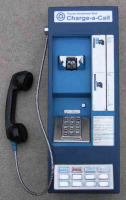








A payphone is typically a coin-operated public telephone, often located in a telephone booth or a privacy hood, with pre-payment by inserting money (usually coins) or by billing a credit or debit card, or a telephone card. Prepaid calling cards also facilitate establishing a call by first calling the provided Toll-free telephone number, entering the card account number and pin, then the desired connection telephone number — also offering the benefit of establishing many telephone number connections during a single payphone session. An equipment usage fee may be charged as additional units, minutes or tariff fee to the collect/third-party, debit, credit, telephone or prepaid calling card when used at payphones.
Payphones are often found in public places, transportation hubs such as airports or train stations, convenience stores, malls, casinos, and on street corners. By agreement with the landlord, either the phone company pays rent for the location and keeps the revenue, or the landlord pays rent for the phone and shares the revenue. Some payphones, particularly at gas stations, are mounted in drive-up kiosk structures that can be used without leaving the vehicle.
Payphone revenues have sharply declined in many places, largely due to the increased usage of mobile phones. Payphone providers have sometimes tried to reverse the decline in usage by offering additional services such as SMS and Internet access, thus making their phone booths into Internet kiosks. The abandonment of payphones by telephone companies has angered some people who consider them a communication staple for low-income consumers.
History
United States
Payphones were preceded by pay stations, manned by telephone company attendants who would collect rapid payment for calls placed. The Connecticut Telephone Co. reportedly had a payphone in their New Haven office beginning June 1, 1880; the fee was handed to an attendant. In 1889, a public telephone with a coin-pay mechanism was installed at the Hartford Bank in Hartford, Connecticut by the Southern New England Telephone Co. It was a "post-pay" machine; coins were inserted at the end of a conversation. The coin mechanism was invented by William Gray; he was issued a series of patents for his devices, beginning with US#454470 issued Jun 23, 1891 for a 'Signal Device for Telephone Pay-Stations' which rang a bell for each coin inserted. He subsequently founded the Telephone Pay Station Co. in 1891.The "pre-pay" phone debuted in Chicago in 1898.
By 1902 there were 81,000 payphones in the United States.By 1905, the first outdoor payphones with booths were installed. By the end of 1925, 25,000 of these booths existed in New York City alone.In 1960, the Bell System installed its one millionth telephone booth. After the divestiture of Pacific Bell (California) and AT&T in 1984, it was not long before independent stores selling telephones opened up. After that privately owned payphones hit the market.
Sources differ as to whether the peak number of payphones in the United States was 2.6 million in 1995 or 2.2 million in 2000.As of 2013, the number is reportedly less than 500,000.The major carriers, AT&T and Verizon, have both exited the business, leaving the market to be served by independent payphone companies.
Other countries
Payphones in countries with unstable currencies have used token coins, available for sale at a local retailer, to activate pay phones instead of legal tender coins. In some cases these have been upgraded to use magnetic cards or credit card readers.